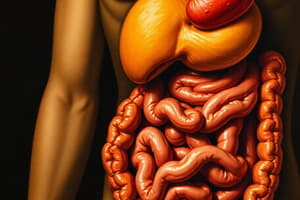Podcast
Questions and Answers
What is the role of teeth and tongue in the process of digestion?
What is the role of teeth and tongue in the process of digestion?
Teeth and tongue physically break down food into smaller pieces.
What are the three main products of chemical digestion in the small intestine?
What are the three main products of chemical digestion in the small intestine?
Glucose, amino acids, and fatty acids and glycerol.
How does the body utilize glucose produced during digestion?
How does the body utilize glucose produced during digestion?
Glucose is used for respiration.
What happens to fat globules during digestion in the stomach?
What happens to fat globules during digestion in the stomach?
Signup and view all the answers
What is the function of the small intestine in nutrient absorption?
What is the function of the small intestine in nutrient absorption?
Signup and view all the answers
What is the significance of the large intestine in digestion?
What is the significance of the large intestine in digestion?
Signup and view all the answers
Explain the term 'chemical digestion' as it relates to proteins.
Explain the term 'chemical digestion' as it relates to proteins.
Signup and view all the answers
What is stored in the rectum before egestion?
What is stored in the rectum before egestion?
Signup and view all the answers
In what form is starch broken down through chemical digestion?
In what form is starch broken down through chemical digestion?
Signup and view all the answers
What type of digestion occurs in the stomach?
What type of digestion occurs in the stomach?
Signup and view all the answers
Study Notes
Why Do We Need Food?
- Provides energy for muscle and organ function, replaces lost energy.
- Supports growth and repair by synthesizing new protoplasm.
- Maintains health through intake of vitamins and minerals.
Components of Food
- Essential components include carbohydrates, proteins, fats, vitamins, minerals, dietary fiber, and water.
Importance of Digestion
- Animals consume food for nutrients; they cannot produce their own.
- Nutrients in food are initially large, complex, and insoluble molecules and must be broken down into small, soluble forms.
- Digestion allows nutrients to be absorbed into cells for use in cellular respiration and energy production.
Digestion Process
- Ingestion: Taking food into the mouth.
- Digestion: Breaking down food into smaller, absorbable forms.
- Absorption: Nutrients diffuse from the small intestine into the bloodstream.
- Assimilation: Utilizing absorbed nutrients for energy.
- Egestion: Eliminating indigestible matter via the anus.
Structure of the Human Digestive System
- Comprised of the alimentary canal and associated organs: liver, gallbladder, esophagus, stomach, pancreas, large intestine, small intestine, rectum, and anus.
- Alimentary canal order: mouth, esophagus, stomach, small intestine, large intestine, rectum, anus.
Types of Carbohydrates
- Polysaccharides: Starch (energy storage in plants) and cellulose (not digestible by humans).
- Disaccharides: Maltose (from starch), sucrose (table sugar), and lactose (milk sugar).
- Monosaccharides: Glucose (main energy source), fructose (fruit sugar), galactose.
Digestion Methodologies
- Physical Digestion: Breakdown into smaller pieces without chemical change (e.g., chewing).
- Chemical Digestion: Breakdown into simpler molecules, requiring enzymes.
Role of Enzymes
- Enzymes are proteins that accelerate chemical reactions, essential for digestion.
- Specific enzymes act on specific substrates (e.g., amylase for starch).
- Enzymes operate optimally at specific pH and temperature ranges; extremes can denature them.
Major Digestive Enzymes
- Proteases: Digest proteins into polypeptides.
- Lipase: Breaks down fats into fatty acids and glycerol.
- Carbohydrases: Digests carbohydrates.
Digestion Sequence in the Alimentary Canal
- Mouth: Physical breakdown and mixing with saliva (starch to maltose).
- Stomach: Churning action mixes food with gastric juices (proteins to polypeptides).
- Small Intestine: Final digestion of carbohydrates, proteins, and fats with assistance from liver and pancreas.
Absorption and Egestion
- Digestive end products absorbed in the small intestine include glucose, amino acids, fatty acids, and glycerol.
- Remaining water absorbed in the large intestine; undigested material stored in the rectum is egested as feces.
End Products of Digestion
- Glucose: Used for respiration.
- Amino acids and fatty acids: Utilized for building body structures and functions.
Studying That Suits You
Use AI to generate personalized quizzes and flashcards to suit your learning preferences.
Description
This quiz covers important concepts related to the human digestive system, including the reasons we need food for energy, growth, and health. It is aimed at students in class 2 Bn to help them understand the functions and components of the digestive system.




